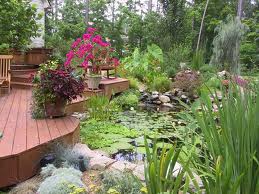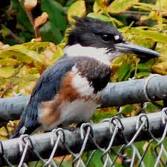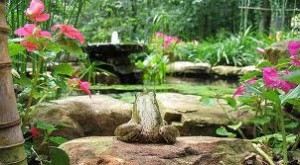





There are two very distinct forms of wildlife gardening. One is based on the dogged desire to do something for the immediate area by providing a haven for local species, ensuring their continued diversity and well-being. This is not so much gardening as nature conservation. On the other hand, there is wildlife gardening in celebration of nature in all its wonder. This is exemplified by the water garden where aesthetics are important, but not overbearing, and where wildlife is the focus of interest and attention, whether it be attracted by a native rush or a rare bog orchid from China.
 Although some may consider that the second course of action produces a vulgar assembly of wildlife hot spots, it will provide the maximum attraction and pleasure for the owner while fulfilling much of the function of the purist’s enterprise. The purpose of such a water garden is to combine what is most productive from a wildlife point of view, using visually attractive species wherever possible.
Although some may consider that the second course of action produces a vulgar assembly of wildlife hot spots, it will provide the maximum attraction and pleasure for the owner while fulfilling much of the function of the purist’s enterprise. The purpose of such a water garden is to combine what is most productive from a wildlife point of view, using visually attractive species wherever possible.
There is no need for this type of feature to be dull. Indeed, with careful planning, it can be as attractive as a pool established for purely decorative purposes. The secret of success is not to insist that every species must be a mecca for a particular creature. Some may be of little merit in this respect, yet will serve a useful function because of their outstanding beauty.
A prime example is the waterlily. It provides beneficial shade for creatures living in the pool, and a place for aquatic snails to deposit their eggs, but the flowers evolved originally to be pollinated by beetles of a kind that died out during the Ice Age. The waterlily survives and continues to prosper because it reproduces freely vegetatively, while other nonspecific insects, which visit the flower, sometimes pollinate it accidentally. So while it is of relatively limited value to aquatic fauna, it is an essential visual ingredient of the well ordered wildlife pond.
The structure of a wildlife pool is quite important if it is to be a success. All the requirements of a conventional garden pool must be met, but with the addition of other beneficial features. The shape and size are not critical, except in the context of the available space and the role that the water garden will play as a feature. If you have no preconceived notions in these respects, it is a case of the larger, the better.
Two of the most important factors in ensuring a stable and diverse aquatic ecosystem are the volume of water and its associated surface area. Most of a wildlife pool must be 30-45cm (12-18in) deep, but it need not be deeper, the overall surface area being much more crucial. Most aquatic fauna functions in the upper 45cm (18in) of water, and there is a danger of greater depths functioning separately and in a manner that is not conducive to the overall well-being of the pool, particularly in the case of large bodies of water.
Shallows are very important, for they provide an escape route for mammals, such as the hedgehog, which may periodically take a tumble. They are also vital for frogs, toads and newts when they wish to leave the pond. Birds love to bathe in the margins, and while there are risks involved in encouraging them to do this, especially if they bathe having just returned from a recently sprayed field, they do provide enormous pleasure. Fish, of course, are very vulnerable if you provide a shallow area, for the heron will come fishing. This handsome bird will appear in the most urban of settings, walk into the pool and take the fish until all have gone. Despite this potential hazard, shallows are invaluable in both attracting and retaining wildlife.
An island in a pool will also be an asset, unless the pool is tiny. In this case, it can create visual clutter and restrict the area of open water unnecessarily. In a large pool, however, an island can make a safe haven for wildlife and, if constructed as a free floating structure, its shadow will offer a private and safe retreat for fish. It is also a place in which more boisterous plants can be isolated, their spread being controlled by the surrounding deep water.
As with other informal pool features, a wildlife water garden should extend beyond the bounds of the pool. It is even more important for planting to spread from dry land, through moist soil, to bog and subsequently the margins. Wildlife diversity comes with habitat diversity, and while open water will attract an enormous number of interesting creatures, thoughtfully planted surroundings will offer accommodation to all kinds of life that is attracted to water.
It is also essential to regard the wildlife water garden as a year-round feature: it need not close for the winter. Birds, in particular, can add greatly to the pleasure it provides, especially if seeding heads of reeds and rushes are allowed to remain. However, few will be ground dwelling birds, and all will appreciate a place to perch, so incorporate some woody structural planting to keep them happy and to provide some visual backbone in the gloomy days of winter.
Where space permits, there will be great opportunities to develop water features for attracting birds. While the general mixed wildlife water garden will certainly attract its complement of visiting birds, there are ways of turning a pool into a miniature bird sanctuary. In addition to the expected range of wild birds, which just come for a drink or to bathe, it is possible to attract waterfowl or, indeed, introduce your own ducks. Careful thought must be given to the latter, however, for although ornamental ducks are fascinating creatures, in all but the largest expanses of water, they will paddle down the margins of the pool and permit very few of the desirable and popular aquatic plants to prosper. They can be very destructive unless thoughtfully catered for.
 Few gardeners have the kind of water garden that will sustain bird life permanently. In general, they will be visitors. This does not mean that they will move on from one pond or feeding site to another and be replaced by others. For the most part, they will return time and again, going off to roost or preen elsewhere. Nesting is a very territorial activity, so it is unlikely that more than a couple of pairs of unrelated species will be persuaded to nest in close proximity.
Few gardeners have the kind of water garden that will sustain bird life permanently. In general, they will be visitors. This does not mean that they will move on from one pond or feeding site to another and be replaced by others. For the most part, they will return time and again, going off to roost or preen elsewhere. Nesting is a very territorial activity, so it is unlikely that more than a couple of pairs of unrelated species will be persuaded to nest in close proximity.
Despite these shortcomings, much can be done to attract birds. The water garden cannot be all things to all birds and, to a great extent, the area of open water will determine whether waterfowl are a viable proposition. Anything less than about 15 x 16m (50 x 20ft) will generally be unsuitable.
Where waterfowl are expected, or will be introduced, shelter must be provided, along with a place for them to rest and preen. There should be a gentle slope into the water, ideally a stone beach so that when it rains, the birds’ droppings will be washed harmlessly away. This problem should be addressed early on, for not only will the droppings be unpleasant, but they will also cause the pool to turn very green by providing abundant nutrients for water discolouring algae. To some extent, the problem can be addressed by substantial planting, which will mop up much of the excess nutrients. However, where there are waterfowl in quantity, green water will always be a potential problem; which ultimately may have to be addressed by the use of algicides.
The shelter required by ducks will be minimal, but if they are to be encouraged to stay, some shrubby planting nearby will help by providing them with privacy. Where the pool is large enough to warrant an island, this will often encourage the birds to nest, although not all ducks are ground nesters; some prefer to inhabit burrows.
Planting plays an important role in keeping birds happy, and although plants can be difficult to sustain, this is by no means impossible if some form of protection is provided early on, especially for the more resilient reeds and rushes. Schoenoplectus of all kinds offer good cover, as does the spire reed and the various bur-reeds. These also provide a limited amount of food, but it is plants like the arrowhead and the Canadian 50 x 20ft (Zizania aquatica) that water fowl regard as delicacies. The overwinteri rig buds, or turions, of the arrowheads are popularly known as duck potatoes, being scooped from the mud by the birds during winter, while the seeds of zizania provide a reliable and much appreciated food resource from autumn into winter.
While birds are the most visible forms of wildlife to be attracted to a natural water garden, many other creatures will live there, too. For these, there are other aspects to consider. Unless a pool that is home to waterfowl is of a substantial size, it is unlikely to offer a suitable environment for amphibians. These like clean water and abundant plant growth, especially underwater vegetation, in which they can hide and which offers some protection for their tadpoles.
 Frogs, toads and newts may not always occupy the same body of water, but one or more species will often live happily together. They will appear quite naturally and suddenly if the conditions are correct, although it is quite possible to introduce them as tadpoles and allow them to naturalize.
Frogs, toads and newts may not always occupy the same body of water, but one or more species will often live happily together. They will appear quite naturally and suddenly if the conditions are correct, although it is quite possible to introduce them as tadpoles and allow them to naturalize.
The only problem with a pond devoted to wildlife lies in ensuring that it looks good. While the fascination with ducks or amphibians can become all consuming, their home should also have a pleasing aspect. Although the plants will be essentially functional, to retain some dignity and beauty, they should be planted in bold drifts or groups. Not only are they likely to be more appealing, but also of greater value than when planted in isolation. A wildlife water garden will never look stunningly attractive, but there is no reason why it should not be pleasing to the eye if the essential plants are positioned carefully and, where possible, the best decorative variety of each species is selected.
Copyright © www.100flowers.win Botanic Garden All Rights Reserved